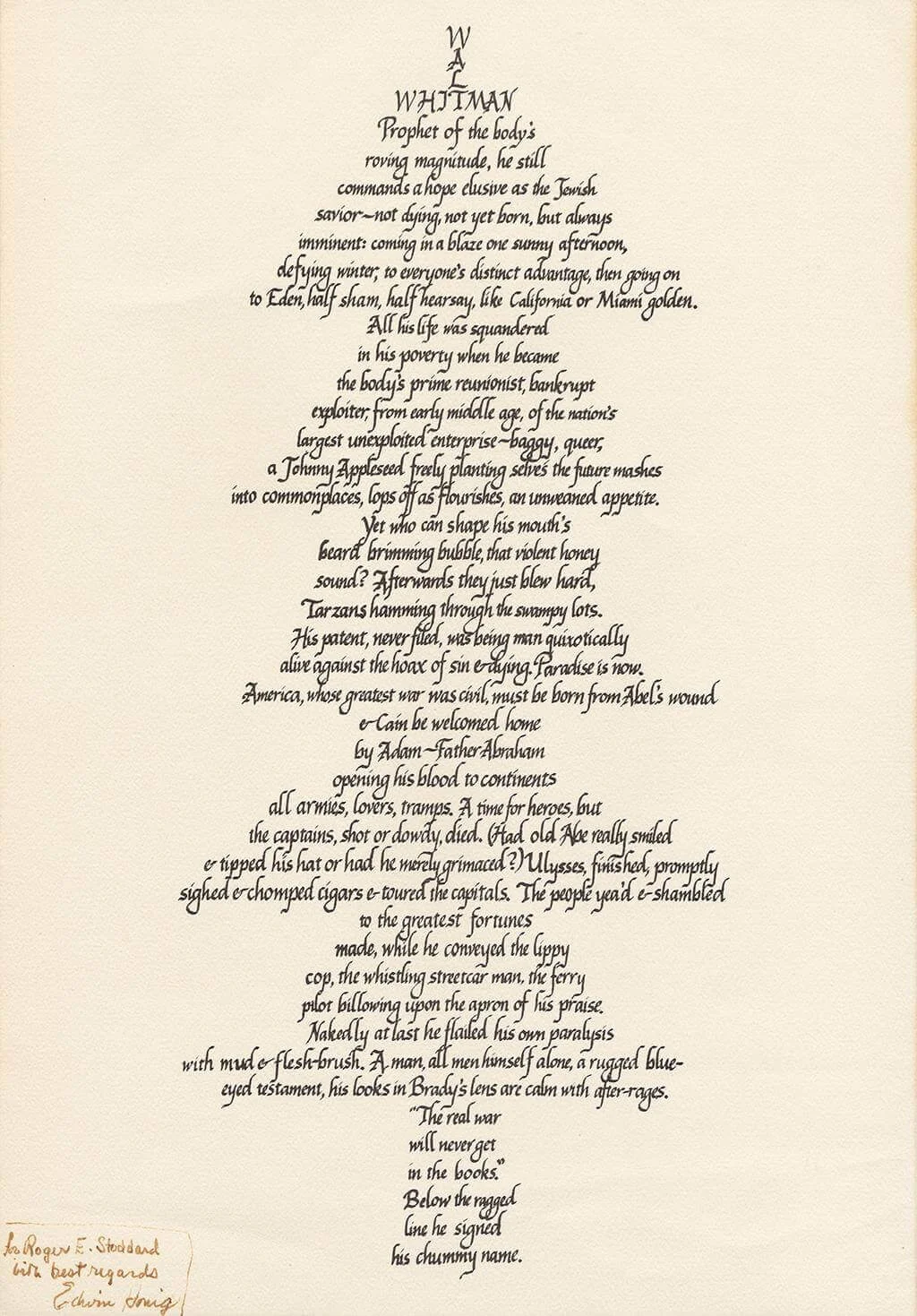Did you know that some language and anthropology scholars believe that poetry predates literacy? Poetry is one of the world’s oldest and most venerated art forms. As storytellers, there’s simply a ton of value in learning more about what makes poetry so special, as well as what makes it so historically important. We’re going to break down the history of poetry by looking at some examples from William Shakespeare and Langston Hughes. By the end, you’ll know how poetry started, what different types of poems there are, and how you can become a master of the craft — but first, a bit of history.
All Types of Poems
What types of poems are there?
What are the different types of poems? Let’s not get ahead of ourselves, first let’s consider this: “when we read poetry less as a form and more as a concept, we can see the poetic all around us.” Perhaps it’s helpful to think of poetry as an artistic medium rather than a structural form.
I’ve found that focusing less on the intricacies of form, and more on the feeling that poetry evokes has helped me appreciate poetry more, whether it be blank-verse, prose poetry, or rap. That quote was taken from a TED-ed by Melissa Kovacs. I highly recommend you check out the video below:
Types of Poem Structures • What Makes a Poem … a Poem?
No matter who you are, you’re bound to have preconceptions about poetry — I know I did and, in many ways, still do. There's a large swath of people who believe poetry is an elitist, self-congratulatory field — and that’s a well-warranted perspective; there certainly are a lot of stuck-up poets.
But hey, maybe that’s what comes with four thousand years of history — perhaps one day film will be regarded in the same way. Without further ado, let’s jump into a poem definition.
POEM DEFINITION
What is a poem?
A poem is a piece of writing that relies on rhyme, rhythm and meter to evoke feeling, or to convey setting and story. There are dozens of different poetic forms, such as verse, haiku, sonnet, and ballad. Although poems aren’t defined by their forms, they are distinguished by them.
Characteristics of Poetry
- Emphasis on Meter
- Often Involves Rhyming
- Meant to Tell a Story or Evoke Emotion
Origins of Poetry
The first types of poems were epic
We can trace poetry all the way back to the Ancient world, in Egypt, Greece, India, and Sumeria. Some of the most influential poems of all time come from this period, and they were epic. No, not epic as in the adjective “epic” but epic in the sense that they were epic poems. But what are epic poems?
Epic Poems
Epic poems are poems of extraordinary length that usually follow a hero’s journey across a vast, and often mythological world.
Examples of epic poems: The Epic of Gilgamesh (Sumeria), Beowulf (England), The Iliad (Greece), The Odyssey (Greece), The Mahābhārata (India), The Ramayana (India), and The Divine Comedy (Italy).
For more on how The Epic of Gilgamesh laid the groundwork for Joseph Campbell’s hero’s journey template, check out the video below:
Types of Poems and Examples • The Original Hero’s Journey
Nowadays, epic poems have gone out of style, but the core idea of what made them so great, lives on in literature, film, and video games.
Epic poems weren’t the only types of poems that existed in the ancient world -- there were different kinds of poems as well, like those of the lyric and dramatic kind. During this period, China had its own different kinds of poems as well, which we refer to today as the Classic of Poetry.
Lyric Poems
Lyric poems are personal poems, usually written in the first person, and often accompanied by some sort of musical instrumentation. Iambs and trochees are often used in lyrical poems. One could argue that Shakespeare’s use of iambic pentameter is poetic, although he used it mostly in his plays.
Dramatic Poems
Dramatic poems are poems that are meant to be spoken aloud. The subject matter of dramatic poems are almost always tragic.
The Different Kinds of Poems
Middle age of poetry brought rhythm
The renaissance period brought about enormous change to the world of poetry. Playwrights like William Shakespeare, Christopher Marlowe, and Ben Jonson, introduced a new poetic form to theater called blank verse.
Blank verse is a non-rhyming poetic form that features a specific meter; often iambic pentameter.
Sonnet
But perhaps the most famous poetic form during this period was the sonnet; invented by Italian poet Giacomo da Lentini. But what is a sonnet? This next video explains everything you need to know:
Types of Poems and Examples • Shakespeare’s Sonnets
A sonnet is a 14-line poem that adheres to a loose structure and has a variable rhyme scheme. Here’s a sonnet example:
Romeo and Juliet, by William Shakespeare
Two households, both alike in dignity,
In fair Verona, where we lay our scene,
From ancient grudge break to new mutiny,
Where civil blood makes civil hands unclean.
From forth the fatal loins of these two foes
A pair of star-cross’d lovers take their life;
Whose misadventured piteous overthrows
Do with their death bury their parents’ strife.
The fearful passage of their death-mark’d love,
And the continuance of their parents’ rage,
Which, but their children’s end, nought could remove,
Is now the two hours’ traffic of our stage;
The which if you with patient ears attend,
What here shall miss, our toil shall strive to mend.
Although this example is taken from one of Shakespeare’s plays, other examples appear in the sonnets Shakespeare wrote outside of his work in the theater. Elsewhere in the world, new poetic forms emerged.
Haiku
In 17th century Japan, the haiku was born, albeit under a different name (hokku). In many ways, haiku epitomizes what we talked about earlier -- poetry is meant to be a reflection of what surrounds us. But what is a haiku?
Common Types of Poems • The Power of the Daily Haiku
A haiku is a three-line poem that uses a syllabic 5-7-5 structure. Here’s an example from Matsuo Basho, the man who many call the master of haiku:
An old silent pond-
A frog jumps into the pond,
splash! Silence again.
Related Posts
Modern Poetry
Contemporary types of poems
Nowadays, poetic forms are taught to kids in school. Some of the most popular poetic forms for beginners are acrostic poems and concrete poems. Both of these types of poems are used to activate the minds of the reader. Let’s take a look at a couple of examples:
Acrostic
An acrostic is a poem that uses the first letter of each line to spell out a message, name, or title. Here’s an example of an acrostic poem, titled “An Acrostic” by Edgar Allan Poe:
Elizabeth it is in vain you say
"Love not" - thou sayest it in so sweet a way:
In vain those words from thee or L. E. L.
Zantippe's talents had enforced so well:
Ah! if that language from thy heart arise,
Breathe it less gently forth - and veil thine eyes.
Endymion, recollect, when Luna tried
To cure his love - was cured of all beside -
His folly - pride - and passion - for he died.
The first letter of each line spells out the name “Elizabeth” whom the poem is dedicated. Concrete poems are an especially creative form for young writers to practice. But what are concrete poems?
Concrete Poems
Concrete poems are structured to make a specific shape. The image below is an example of a concrete poem, titled “Walt Whitman” by Edwin Honig.

Types of Poems and Examples • Concrete Poetry
As you can see, Honig’s “Walt Whitman” is shaped as a pine tree. But the classroom wasn’t the only place where poetry has been taking new forms.
During the 20th century, poetry was used as a tool for social resistance on the street. Writers like Countee Cullen and Langston Hughes used poetry to offer insight into the experiences of black Americans.
By the 1920s, an artistic revolution was underway in urban centers, particularly in New York City’s Harlem neighborhood. This next video explores the importance of the Harlem Renaissance:
Types of Rhyming Poems in the Harlem Renaissance
Hughes’ used influence from jazz and blues music to give a lot of his poetry a unique rhythm. Although not directly, Hughes’ rhythm would go on to inspire Rudy Ray Moore, and subsequently, the birth of rap music. Here’s an example of one of Hughes’ most famous poems, “I, Too.”
I, too, sing America.
I am the darker brother.
They send me to eat in the kitchen
When company comes,
But I laugh,
And eat well,
And grow strong.
Tomorrow,
I’ll be at the table
When company comes.
Nobody’ll dare
Say to me,
“Eat in the kitchen,”
Then.
Besides,
They’ll see how beautiful I am
And be ashamed—
I, too, am America.
In 2018, Kendrick Lamar won the Pulitzer Prize for Music, marking a huge step-forward for contemporary poetry. This next video explains how Lamar won one of the writing world’s most prestigious awards:
How Kendrick Lamar Won the Pulitzer Prize
Hip-hop is just one popular poetic form that’s used today — many of the forms we talked about earlier are still used by creative writers and academics. By tracing poetry’s evolution, we can begin to identify a trend that shows how poetry is perhaps the most iconic type of writing for reflecting our innate understanding of the world.
Related Posts
UP NEXT
What is iambic pentameter?
We briefly talked about iambic pentameter in this article but there’s so much more to it than what we touched on here. In the next article, we break down everything you need to know about iambic pentameter, with examples from Shakespeare plays, poems, and rap songs. By the end, you’ll be ready to apply iambic pentameter in your own works, or recognize it in others’.

Great write up. I love writing in free verse, but I’ve put together sonnets, ryhme and longish poems. Currently working on an epic poem which is taking longer than expected. ?? What are your views on free verse or free form poetry?
Can anyone suggest the type of my poem by seeing it.
Very informative. Love the article
Thanks for doing something positive for poetry. A note in haiku section might have been helpful, because the three-line, 5-7-5 structure is no longer a rigid requirement.
Also, Mr. Poe's name is not spelled correctly. A proofreader would have been a good investment here.
Thanks, Sandy!
Very informative
Thanks for posting this.
I came here for poetry.
Disappoint, it didn't.
Hey you made a mistake. Hip hop isn't rap I know come from there. Hip hop was created not rap. Rap is rythm and poetry. That's much older than hip hop. Research it if you dont believe me. Rap can be found in ancient text as spoken word poetry. Just giving a point of view. My father was a teacher he knew this.
what type of poem uses the last line in a stanza as the 1st in the next stanza.. ending up
with the last line in the last stanza is the 1st line of the 1st stanza.. I don't know what this is called
Are there any more types?
Thank you for the accurate information
is there any poem that u know about sedilame molapisi
Thanks in advance. I look forward to learning more about poetry
Great